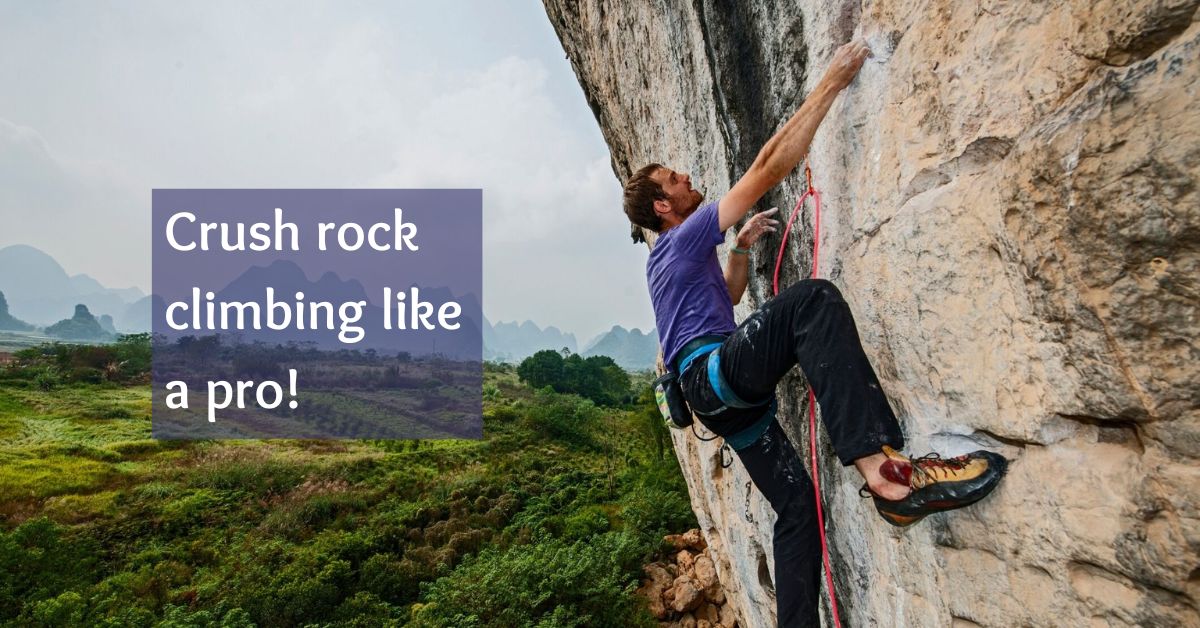Rock climbing is a sport in which participants climb up, across, or down natural rock formations. Rock climbing is a physically and intellectually difficult sport that frequently puts a climber’s strength, endurance, agility, and balance to the test, as well as mental control.
It may be a dangerous sport, therefore knowing good climbing techniques and how to use specialist climbing equipment is essential for safely completing climbs. Here is your complete guide for How To Get Better At Rock Climbing?
Complete Guide To Your Rock Climbing Skills
What skills do you need for rock climbing?
Problem-Solving
All of the following require problem-solving abilities because climbers must find out where everything is. Going outside and climbing is the best way to train yourself to think about these things.
Smearing
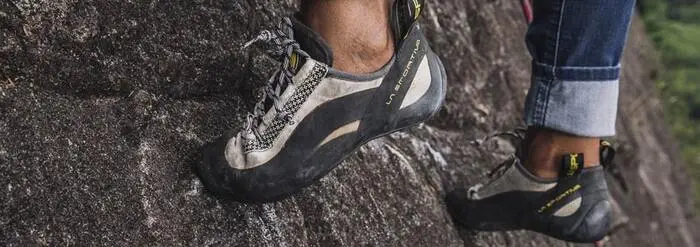
Outside, finding a foothold can be obvious, but you may have to do a lot more spreading. This is when you place your climbing shoe directly against the rock and use friction to rise up to acquire vertical ground. To keep your balance, you must master this talent. The more pressure you put on your toes, the steeper the terrain.
Edging
The size and shape of footholds vary. You will certainly come across tiny ones that do not precisely suit your foot. So, what now? You must be able to edge. You must work with your shoe’s large toe area.
You can move up the rock until you discover a handhold to stay steady until your next move by holding your inside edge, where you should rest your body weight, onto a footing.
Putting the gear away
“The most difficult part of rock climbing is getting the gear down. Most of the time, there is no permanent anchor, which is how the climber or rope is linked to a rock. You must remove all of the equipment you placed on the rock. You don’t want to leave any gear behind since it could get in the way of other climbers and jeopardize them.
Don’t lower more than one quickdraw. Tie a number 8 bite of rope through the anchors at the top. Come down by attaching the rope to you using a locking carabiner. Untie all of the knots as you go down, and then pull the rope down.
Abseiling
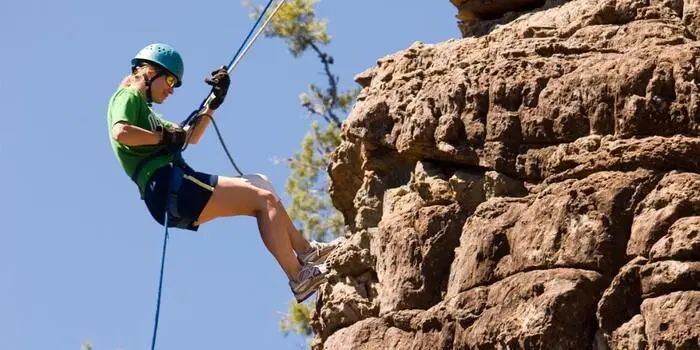
Abseiling is descending rope while wearing a friction device attached to your harness. It is used to navigate terrain that would be too risky or time-consuming to traverse on foot.
As you leave the horizontal cliff top for the vertical cliff face, the take-off is often the most difficult element of abseiling. If you find it awkward, sit on the edge and slowly slide off. This lowers your center of gravity and increases your stability.
Rest
You won’t be able to reach the summit in one swift ascent; you’ll have to take a break at some point. “Find a very good hole and stand on your feet,” Laine advises. Transfer from one arm to the other.
Another strategy is to move swiftly through the most difficult parts and rest at the simpler ones.
Gripping
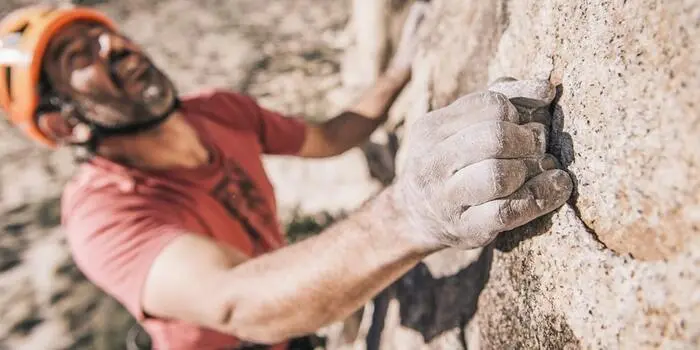
Remember to make the most of the space between your hands and the grips. Consider the word “maximize.” Apply as much pressure as you can to make it simpler to raise your body with the grasp. Weight imbalance is a risk factor for injury. The weight should be distributed evenly across all fingers.
Rock Climbing Tips For Beginners
Invest In High-Quality Equipment

It may seem apparent, but if you want to become a decent climber, you must invest in proper equipment. Wearing inappropriate clothing and footwear not only increases your chance of injury but renting new gear every time you go climbing will cost you a fortune.
Although it may appear to be costly at first, decent-quality gear will be far more helpful in the long run, especially if you plan on climbing frequently. But don’t get too carried away – as a novice, you don’t need everything. But as you progress this might be one of the most important rock climbing tips.
You can check out some good Rock Climbing equipment here on Amazon.
Find An Instructor

Learning from the best is one of the most crucial rock climbing recommendations for beginners. There are so many new strategies to learn when starting off. The best way to ensure you’re taking in everything is to meet with someone who knows what they’re talking about.
There are several ways to accomplish this. Climbing gyms are an excellent location to start if you live near one or can easily commute to one. You’re in luck if you can find a certified rock climbing instructor to train with.
Similarly, membership in a respectable organization such as the British Mountaineering Council demonstrates how enthusiastic and knowledgeable they are about rock climbing.
Climb With A Buddy
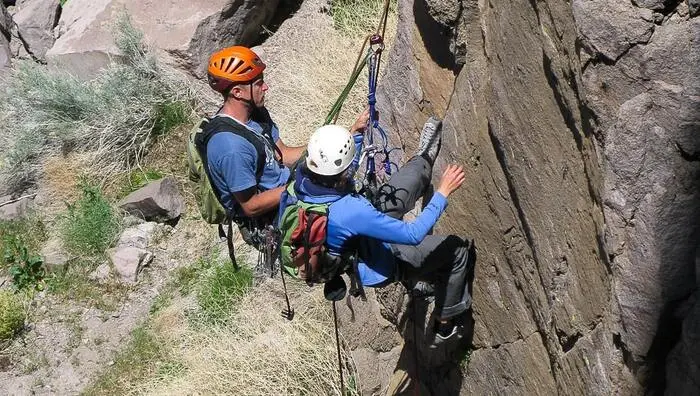
Everyone gets by with a little aid from their buddies. Rock climbing is no exception, and another vital recommendation for beginners is to climb with a partner. They may not be instructors, but they will be able to assist you in your first few climbs and provide important information.
Your belay partner is the more technical word for this person. As you gain climbing confidence, your belay partner will remain on the ground to hold your rope and catch your falls.
However, when you’re first starting out, climbing in pairs is a terrific way to keep your motivation up and add a competitive aspect to your progress.
Progress Intelligently
Make no mistake: rock climbing is difficult. One of the most common mistakes newcomers make is rushing into things and expecting immediate results. Rather than learning and developing at their own pace or taking things one step at a time, many rookie rock climbers approach the sport as if it were a race, often disregarding technique and skill.
It’s okay if it takes you longer to reach the summit than someone else. Don’t be too hard on yourself, and trust the process.
Don’t feel obligated to climb every day, either. For beginners, two or three sessions per week are the suggested amount of rock climbing time. Any more than that, and you risk exhaustion and injury. It is one of the most important beginner rock climbing tips.
Practice the Silent Feet Technique
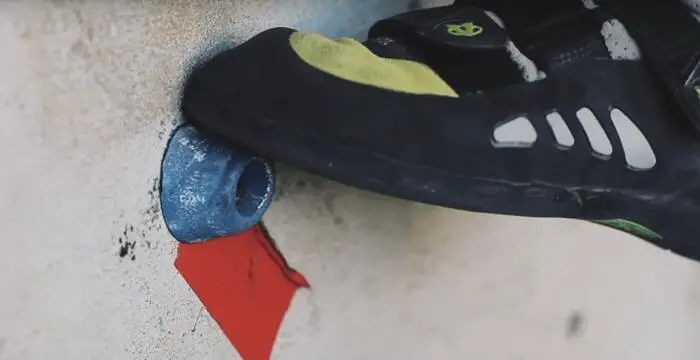
Your footwork will be horrible on your first ascent. Don’t be too hard on yourself; everyone’s footwork is bad. This is because most people make the error of only gazing up while climbing and not paying attention to their feet at first.
However, practicing the silent feet method is one of the most effective strategies to begin improving your technique. Yes, it is as easy as it sounds. When placing your feet on footholds when climbing, strive to create as little noise as possible – ideally, it should be silent.
Though it may appear basic, it means you’ll begin to pay much more attention to your footwork, which is one of the most useful pieces of rock climbing advice for beginners.
Attend Events To Watch And Learn
Professional climbing competitions will give you a firsthand look at how the pros do it, just as a competent instructor would guide and assist you through the nitty-gritty. Take it all in, ready with a notepad, pen, and camera. Take in the environment, observe the displayed technique, and be inspired.
Attending these events also helps you to meet other climbers and grow your climbing community.
Practice Falling Off

As a rock climber, you will tumble off. It’s unavoidable, so you may as well learn the technique. All successful climbers intentionally fall to learn how to do so effectively. You should do the same – practicing falling off will reduce your chances of getting hurt when it happens in real life.
Your instructor will walk you through everything, but here are a few crucial points to remember: If you’re using a rope, keep it in front of your feet at all times during the climb; getting it twisted could lead you to tumble upside down.
Before coming off the wall, communicate properly with your belay partner. Don’t force yourself off the wall; you’ll swing back and collide with it at high speed, which will hurt.
The descent can also be divided into three parts. They are as follows:
- Coming off the wall
- Falling
- Landing
Keep Your Arms Straight

The most crucial rock climbing tip for beginners is to keep your arms straight. Climbing with bent arms can have a negative impact on your performance in a variety of ways. For starters, it’s typically a sign that your arms are supporting significantly more of your body weight than they need to, which means you’ll exhaust much faster.
And, let’s face it, becoming weary quickly is really demotivating, especially for a newbie. When you bend your arms, you also limit your reach, which might make climbs appear more difficult than they are.
Though it appears to be a simple method, climbing with straight arms is critical. Consider how you regularly carry your groceries home: are your arms straight or bent? Consider why this is so.
Strengthen Your Core

Most people believe that in order to be a successful rock climber, you must have tremendous upper-body strength. Your core strength, perhaps shockingly, is far more significant.
So, if you’re familiar with hobbies like yoga, gymnastics, or pilates, you’ll have an advantage on the climbing wall. Even if you aren’t, there are numerous simple ways to exercise your core, both in the gym and at home.
Warm Up Properly
Rock climbing, like other sports, necessitates a proper warm-up if a major injury is to be avoided. Despite this, many of us ignore this critical aspect of climbing. Get into excellent habits early on, and make sure your climbing preparations include a good, consistent warm-up regimen.
Jumping jacks, leg swings, arm and wrist circles, lunges, squats, and push-ups are all good ways to loosen up and get your blood flowing. However, you do not need to go overboard – ten minutes is sufficient for a warm-up.
Proper Nutrition
Any experienced rock climber will have a toned, strong, and healthy-looking physique, but this does not happen by chance. Because of the tremendous strength and endurance required for rock climbing, you burn a lot of calories doing it, therefore it’s critical to feed your body with the correct foods.
As a beginning, divide the task into three pieces. Before a climb, consume a variety of healthy fats, carbohydrates, and proteins, such as avocados and nuts. During a climb, fast sugars from energy bars will keep you going.
After a climb, refuel with complex carbs such as brown rice and potatoes. Muscle healing will be aided by protein in particular.
Have Fun
It’s easy to get caught up in solemnity, gym etiquette, and overthinking your technique. But don’t forget that rock climbing is supposed to be enjoyable, exhilarating, and social. As a novice, never lose sight of why you started in the first place.
To begin, treat climbing like a game, and if you feel yourself becoming frustrated, simply move away and take a break. In the long run, having fun will make you a better climber, which is why you started reading this blog in the first place, right?
Tips To Get Better At Rock Climbing
Nobody is flawless and therefore everyone has to train their way to become a perfect rock climber. The goal of your training should be to discover new climbing techniques to master and correct undesirable habits and techniques. Climbing is a skill activity that mainly relies on muscle memory. Because it is difficult to out-train a poor habit, muscle memory can work for or against you.
To learn how to climb better, you must first understand your strengths and shortcomings. Ask someone you train with if they have noticed anything unusual about your technique, or record yourself climbing so you can criticize yourself. You can work on the following points to improve your rock climbing skills.
Stance

Climbing relies entirely on your feet. When you first start climbing, it’s easy to focus on your upper body strength, but learning where to place and weigh your feet lowers the strain on your forearms and puts your body in a better position to reach for the next handhold.
Use tiny, regular foot movements to show progress in real rock climbing. Try working at a 3:1 ratio, meaning three-foot motions for every hand movement. This type of climbing will teach you to maintain your body close to the wall and your weight on your feet which is extremely important.
Consistency
Practice makes you perfect, so be consistent. Climbing multiple times each week, even if only for a few minutes, can help you enhance your muscle memory and body awareness.
Many climbers are familiar with taking a few weeks off from climbing or being inconsistent with their training and feel as if their progress has vanished as a result. To avoid this, aim to maintain consistency in your training! This is the finest strategy to improve your technique, especially in the early years when consistency is essential for muscle memory formation.
Constantly Push Yourself

You will be unable to improve if you continue to climb at the same difficulty level. This means you should climb routes that are difficult and take your full effort. Don’t be afraid; your body will adapt to whatever stimulation you give it. A good rule of thumb is that if you can fire everything in two or fewer attempts, you’re not trying hard enough to stimulate progress.
Set a goal for yourself, ideally something that motivates you. A project is a great method to combine your strengths and shortcomings. Don’t anticipate doing all of the maneuvers on your first attempt; keep reminding yourself that if you’re trying hard, anchors or no anchors, you’re progressing!
Change Things Up
When you hit a mini-plateau, switch between climbing disciplines to rekindle the fire. This also provides an excellent opportunity for strength development and learning new methods.
Have you completed all of the routes in the gym at your red-point limit? For fresh angles, try going to a new gym or ditching the harness for a month and rock climbing. Alternatively, if you mainly climb indoors, try going outside for a few weeks and vice versa. Have you had a trad slump? Try using clip bolts.
Adding endurance from sport climbing, head power from trad climbing, and raw strength from rock climbing to your CV will aid you in all disciplines.
Alternatively, simply change the climbing area and rock type. Different rock kinds present different obstacles in terms of footwork, sequencing, and body alignment. This diversity improves strength and technique by allowing you to try new motions in different holds.
Patience
Climbing takes equal parts strength and ability. There are no shortcuts; developing efficient movement and delicate footwork might take years of practice. Climbing, on the other hand, is a cerebral as well as a physical sport.
Building strength will only get you so far if you don’t work on your mental and logistical skills. Allow yourself the time to practice your climbing technique over several seasons and embrace failure as a natural part of the process. Remember, it’s all about the ascent.
What should you not do when rock climbing?
Overreliance On Arm Strength
Using one’s arms to pull up and support one’s weight results in early tiredness and harsh, jerky movement. It will also hinder advancement because stamina and efficiency become more crucial as grades rise.
Thrusting upwards from the legs conserves upper body strength for when it is truly required. In general, the arms are best employed for placement and stabilization rather than for lifting up. Make it a habit to move and support your weight with your powerful leg muscles. When moving up the wall, practice putting your feet first, then your hands.
Climbing With Bent Arms
The muscles work significantly harder when the arms are bent than when they are straight. Constantly utilizing bent arms causes early fatigue and might result in an “arm pump,” in which the forearms become painful and weak due to lactic acid buildup.
Keep the arms straight whenever feasible. The benefit of keeping the arms straight is that it allows the skeleton to bear the effort rather than the arm muscles. The weight load should be carried by the legs, therefore ensure that it is the legs, not the arms, that are supporting you.
If you do end up with sore, pumped arms, top climber Eric Horst recommends a method called G-Tox to recover rapidly while on the wall. His approach entails holding one arm above the head for five seconds, shaking it for five seconds, lowering the arm, then shaking it for five seconds again. Rep with the opposite arm.
The G-Tox approach increases blood flow and flushes out lactic acid, hastening the recovery of grip strength.
Overgripping
Clutching holds with a death grip induces early fatigue, and the additional friction causes skin abrasion sooner than if a milder grasp is used. Chafing on the skin may not appear to be a big deal, but the pain of raw, tender skin can put an end to a rock climbing session early.
Use as gentle a grip as possible and no tighter than necessary for longer endurance and happy skin. How much traction is truly required? Test this out for yourself, on the wall, and close to the ground. See how relaxed your hold may be before you begin to slip.
Keep in mind that anxiousness increases the likelihood of exhaustion, even with light exercise. When we are scared or apprehensive, we tire more rapidly; when we are calm and confident, we have more endurance.
Slow, deep breathing is a rapid treatment for anxiety. Breathing at a rate of roughly 6 breaths per minute stimulates the vagus nerve, which automatically calms the body.
Not Paying Attention To Where You Put Your Feet
When ascending, only gazing up indicates that the feet are not receiving adequate attention. Poor footwork and lost footholds result in a dysfunctional reliance on the upper body.
Spend the same amount of time searching down for footholds as you do up for handholds. Scanning the wall to your right, left, below, and upwards should be a priority.
Foothold recognition drills, best done on an outdoor rock face, are recommended by renowned boulderer John Sherman. Standing in front of the boulder, point out five footholds quickly, then another five, then another five. The first ones you’ll point to will be enormous, obvious ledges.
The final ones will most likely be little, hardly visible cracks. This drill, when done quickly and in a timed manner, is excellent for developing an instinct for identifying footholds.
Holds With Middle Of The Foot
On holds, using the center of the foot is difficult since it fixes one’s position and prohibits rotating. There are various foot placement options, each with its own set of benefits.
The toe-in-foot position allows for swiveling and adds a few inches of reach. The foot is straight up against the wall, with the toes resting on the grip. However, because only the toes are supported by the grip, the toe-in necessitates the use of strong calf muscles to support the rest of the foot.
For beginners, holding a toe-in for too long will cause calf muscles to quiver and weaken from pump-out.
Edging offers more stability than toe-in. The inner edge of the shoe’s toe box, from the big toe to the ball of the foot, is resting on the hold with inside edging. The outer edge of the toe box rests on the hold in the outside-edge position.
When more of the shoe makes contact with the hold, there will be more grip and stability with both of these foot positions. As a result, the foot should be placed at an angle that optimizes the amount of sole that touches the surface of the grip.
When taking a momentary rest on the wall, using the heel rather than the center of the foot is preferable. Place your heel on a large grip and maintain your leg straight to support your weight.
Too Much Readjusting Of Hands And Feet
Obsessively adjusting the grip to reach the perfect hand position slows you down, costs energy, and creates unwanted skin abrasion. Even little changes in foot location can cause the foot to slide out of the grasp.
Place your hands cautiously and leave them how they are until you begin the next motion. Place the feet gradually and carefully the first time, and resist the need to move them. Approaching holds should be done slowly. Before you put your hands and feet down, think about where they should go.
Ignoring Body Position
Inexperienced climbers approach the climb like a ladder, with the seat and hips held away from the wall and the body looking straight into it. This straight-on, ladder-style posture is excellent for novice routes with huge jugs that are lightly slanted.
On most rock climbing climbs, however, this position leaves too much distance between the body and the wall, causing considerable strain on the arms. Thus learning rock climbing body position is important.
Engage the core and pull the hips into wall-hugging positions when making a motion. Hug in closer by tucking your hips and shoulders against the wall. Maintain the body’s center of gravity beneath the grips.
Learn to be comfortable with having your center of gravity in varied postures with non-vertical body positions. Learning to lean like this opens access to more complex maneuvers.
Making Use of Dynamic Moves When Static Moves Will suffice
Leaping and being airborne in order to reach a hold increases the risk of injury, particularly to the shoulders (1). It is based on strength rather than skill, and it depletes one’s energy reserves.
Dynos are fantastic on occasion, but they should be limited to circumstances where there are no other options, especially on longer problems or higher grades where stamina is required to last.
Eric Horst advises limiting dynamic lunges to instances where you are confident of succeeding, have no other choice, or where a static sequence would take more energy than the jump.
Tips and Techniques For Intermediate Climbers
Dynos
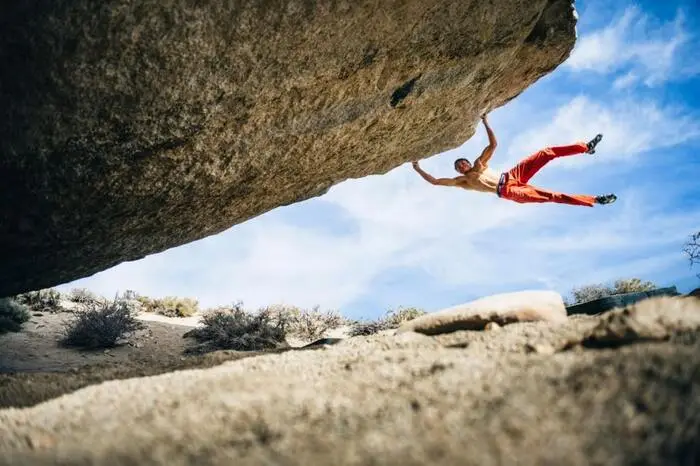
Dynos are jumping moments that will put your strength and skill to the test. Dynos are mostly utilized when the next hold is out of reach while rock climbing.
A good foothold is essential when doing a dyno. You then squat down slightly, shifting your center of mass away from the wall. Then simply hop up with your legs. To avoid popping your shoulder or dangling aimlessly on the hold, stretch your arms wide to catch the hold and instantly restrict them.
You should do dynos indoors. If your gym lacks dyno-friendly routes, use climbing tape as practice tags.
Twisting
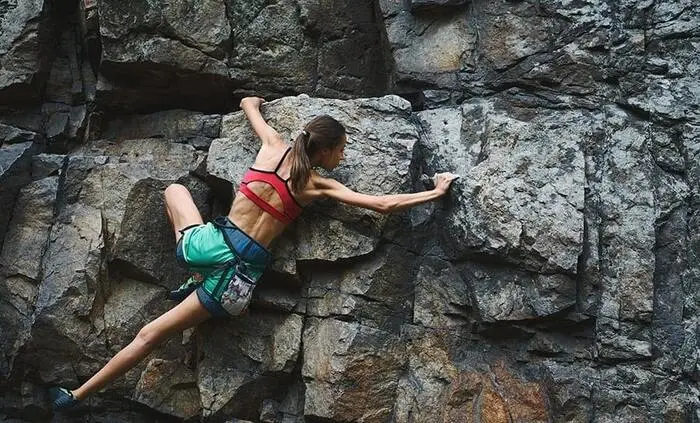
You’re rotating your hips and upper body to grip the next hold and establish a more solid hanging position, as the name implies. The idea is to bring your hips as near to the wall as possible while maintaining your balance.
Twisting helps intermediate climbers get into good positions and boost climbing efficiency. To twist effectively, engage your core while twisting (moving your hips) and maintain your arms stretched.
To prevent cutting loose easily as the climbs become steeper, a twist on overhangs.
Crossing Through
The cross-through maneuver is fantastic for grabbing two successive grips on the same side without getting into an awkward posture.
To complete a left cross-through, lock your body onto the wall with the two footholds and one handhold with your left hand. Release your right hand from the hold, twist your hip with your left arm, and grab the left hold.
Gaston
A gaston is when you put so much pressure on the holds on each side that the counter pressure keeps you on the wall. It’s not a move you should employ frequently. When your footing is shaky and you’re forced to sustain your body weight with just your hands, Gaston is your backup maneuver.
Tighten your core muscles as much as possible when performing a gaston. If you don’t, you’ll lose arm strength and fall in seconds.
Drop Knee
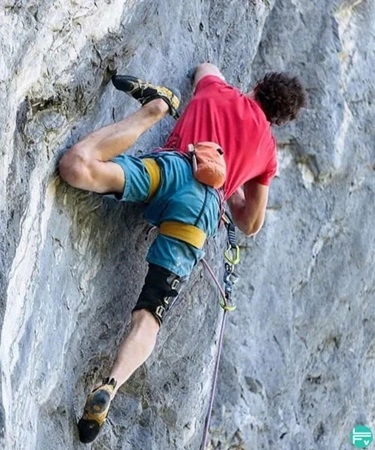
Drop-knee is a simple maneuver that can make even the most difficult routes a little simpler. Place your foot on one grip and then twist your knee towards the center of your core to complete a drop knee. It might be as basic as a hip twist or as complex as dropping your entire knee onto a hold below.
You’ll be in a more stable position, with the next hold within arms’ length. All you have to do is push, grab, and move up.
Heel Plants
The heel plant allows you to twist and drop your knee at the same time, with some exceptions. You put a lot of weight on your feet and move near the wall while remaining stable. It’s essentially a rest position designed to let you catch your breath amid difficult problems.
Pulling yourself up by putting pressure on the back of the heel is a common mistake during heel plantings. Instead, grab the hold with your knee pointing out from the side of your heel. Then raise yourself.
Once you’re up, slowly rotate your foot and grab the hold from the bottom, slightly arching your toes forward. Your knees and hips should be in close proximity to the wall. Mastering this technique is one of the most important rock climbing tips for intermediate climbers.
Crimps
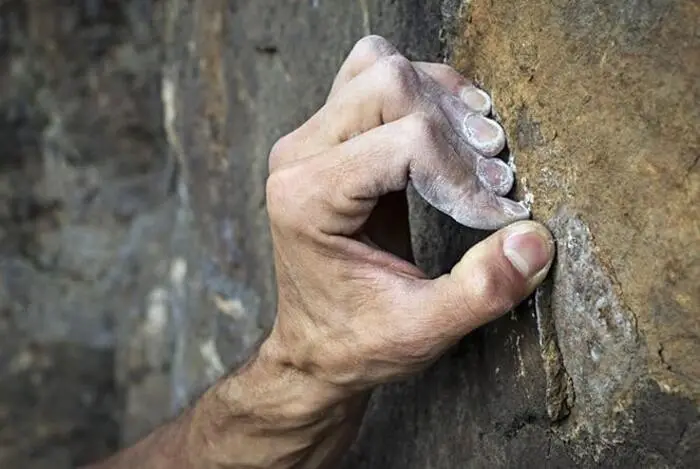
Crimping is an intermediate climbing technique in which you grip hold of the wall with the tips of your gingers. The open crimp is a simple technique in which you clasp the hold with your fingertips while keeping your palm open and pointing downwards.
When your palm pushes towards your fingertips through the hold, your thumb is put over your index and middle fingers to lock them in.
In a pinch, use closed crimps to keep yourself tight. But keep in mind that a closed crimp cannot be adjusted. As a result, open crims should be used instead for flexibility and adjustability. When crimping, arch your fingers over the tip. You’ll be weary and unable to pull yourself up if you don’t.
This concludes our article on How To Get Better At Rock Climbing. With patience, and hard work, and by following this guide, you can upgrade your climbing skills. We hope you like this and find this helpful. Please share and comment down your suggestions below.
You may also like 5 Safety Tips To Survive An Avalanche On A Snowmobile
FAQs (Frequently Asked Questions)
How do I get stronger at rock climbing?
The only way to get stronger at rock climbing is to practice it frequently. Try to practice the techniques that are required for rock climbing. Also, you can do certain exercises to strengthen your core, arms, and back to maximize your performance.
How do beginners improve climbing?
Beginners should do the following things to improve their rock climbing skills:
1. Invest in high-quality climbing equipment.
2. Find a teacher.
3. Find a climbing buddy.
4. Learn the fundamentals of climbing grades.
5. Try not to take on too much too quickly.
6. Use the silent feet technique.
7. As a spectator, attend a professional event.
8. Experiment with falling off.
How long does it take to get good at rock climbing?
Getting “good” at climbing normally takes around 4 years of indoor climbing, but clearly, this depends on a variety of factors here, and it also depends on what you regard as “good”. V5 in bouldering (V scale) or 5.11 in rock climbing (YDS scale) are considered above average.
Why do I feel so weak climbing?
During a long day of climbing, your body begins to rely more on blood glucose due to decreasing glycogen reserves, and you get increasingly exhausted.
What V level makes you a good rock climber?
Climbers can find good hands and footholds at 5.0-5.4. The inclination of 5.5-5.7 is higher but still affords easy grips. 5.8 +/- indicates a vertical climb with small, difficult hands and footholds. 5.9 +/- indicates the possibility of overhung paths and smaller grips.
What is the most important skill in rock climbing?
One of the most crucial components of climbing is foot placement on the wall because your feet must bear as much of your body weight as possible in order to climb efficiently. Check that your hips are near the wall.
How do I get better at rock climbing?
You can do the following things to get better at rock climbing:
1. Footwork
2. Consistency
3. Challenge Yourself Constantly
4. Change It Up
5. Patience

